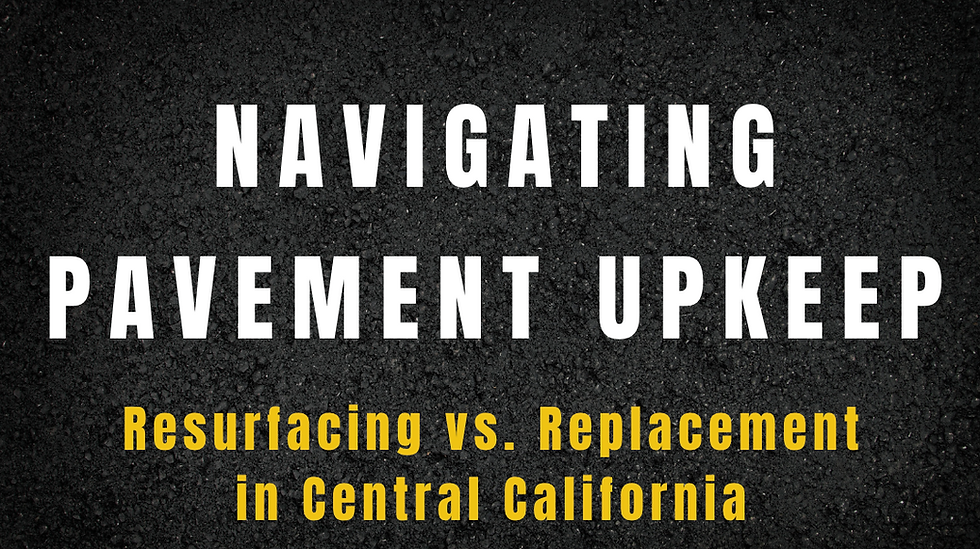Crack Prevention 101: Minimizing Stress on Concrete Surfaces
- Central Coast Paving
- Nov 10, 2023
- 3 min read

Concrete is the backbone of modern construction. However, even this stalwart material has its Achilles' heel—cracks. These unwelcome fissures not only mar the surface aesthetic but can also signal deeper structural issues. Understanding the common causes of cracks and how to prevent them is essential for any property owner or construction enthusiast. In this comprehensive guide, we delve into the strategies for maintaining the integrity of concrete surfaces.
The Common Culprits Behind Concrete Cracks
Before we dive into prevention, let's address the culprits behind the cracking. Concrete may crack due to:
Environmental Stress: Temperature fluctuations cause concrete to expand and contract, leading to stress cracks.
Subgrade Settlement: Insufficiently compacted or shifting subgrade can create uneven support for the concrete.
Overload: Excessive weight or strain can exceed the concrete's load-bearing capacity.
Rapid Drying: If concrete dries too quickly, usually due to high temperatures or wind, it can lead to shrinkage cracks.
Improper Curing: Curing concrete slowly and evenly is critical. Incorrect curing can result in surface or structural cracks.
Control Joints: The First Defense Against Cracks
Control joints are planned fissures that allow concrete to expand and contract without causing random cracks. Placing control joints at strategic locations dissipates the stress across a slab, reducing the risk of unsightly cracking. Here's what to consider:
Placement: Joints should be spaced at intervals no more than 24 to 36 times the thickness of the slab in inches.
Depth: A control joint must be cut to at least one-quarter of the slab thickness to effectively control cracking.
Timing: Cutting joints too early can cause raveling, while too late can result in uncontrolled cracking. The optimal time is typically within 6 to 18 hours after finishing in typical concrete.
Quality Materials: The Building Blocks of Durability
The adage "you get what you pay for" holds particularly true with concrete materials. High-quality concrete mixes may cost more upfront, but they pay off in longevity and reduced maintenance costs. Key considerations include:
Aggregate: Well-graded, quality aggregate minimizes the chances of cracking.
Water-Cement Ratio: Too much water weakens the concrete, leading to possible cracking. A low water-cement ratio allows for consistent workability requirements.
Additives: Certain additives can enhance the concrete's properties, making it more resistant to environmental stressors.
Proper Construction Techniques: Laying the Foundation Right
The method of construction has a profound impact on the incidence of cracks. Here are some best practices:
Subgrade Preparation: The subgrade must be properly compacted and moistened before pouring concrete.
Reinforcement: Using rebar or wire mesh can provide additional support to the concrete, distributing loads and limiting crack width.
Curing: Slow and controlled curing conditions allow concrete to achieve its intended strength and durability.
The Science of Curing: The Art of Patience
Curing is not just a step in the process; it's an art that requires patience. Proper curing:
Maintains Moisture: This prevents the concrete from drying out too quickly, reducing the risk of shrinkage cracks.
Controls Temperature: Keeping the concrete at an even temperature helps prevent thermal stress.
Takes Time: Depending on the product and environment, curing can take anywhere from three days to several weeks.
Monitoring and Maintenance: The Long View for Crack Prevention
Finally, even with all the right steps taken, monitoring your concrete for the first signs of stress is crucial. Early detection can mean simpler, more cost-effective repairs. Regular maintenance, such as sealing joints and repairing small cracks, can prevent larger issues.
By understanding the intricate dance between the forces that act upon concrete and the best practices to counter them, we can ensure our concrete surfaces remain robust and intact. Implementing these strategies is not just about aesthetic preservation—it's about cost-effective, long-term infrastructure maintenance.
Do you have cracks throughout your concrete and are looking to finally do it the right way? Contact Central Coast Paving to make sure your new concrete looks and stays in tip-top shape. Call us today at (805) 665-3292.




Comments